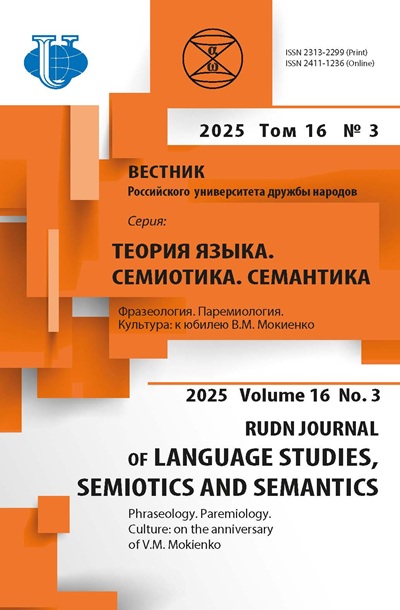ТРАНСЛИНГВАЛЬНЫЙ И ТРАНСКУЛЬТУРНЫЙ АСПЕКТЫ СТИЛИСТИЧЕСКОГО ВЫДВИЖЕНИЯ В ХУДОЖЕСТВЕННОМ ТЕКСТЕ (на материале поэзии О. Сулейменова). Статья 1
- Авторы: Джусупов НМ1
-
Учреждения:
- Университет «Сырдария»
- Выпуск: Том 8, № 3 (2017)
- Страницы: 519-530
- Раздел: СТАТЬИ
- URL: https://journals.rudn.ru/semiotics-semantics/article/view/17013
- DOI: https://doi.org/10.22363/2313-2299-2017-8-3-519-530
- ID: 17013
Цитировать
Полный текст
Аннотация
В статье на материале поэзии Олжаса Сулейменова исследуются средства выдвижения (языковые девиации), основанные на естественном транслингвокультурном мышлении, билингвальном сознании. Как правило, в произведениях О. Сулейменова наблюдаются языковые девиации разных уровней, обусловленные его авторским заданием на оказание эффекта выдвижения под влиянием казахского (генетически родного) языка для создания русского поэтического текста. В статье анализируются два типа лингвокультурного отражения действительности в тексте поэта-транслингва - подсознательное и специальное (преднамеренное). Сплав казахского и русского в поэзии О. Сулейме-нова рассматривается как слияние различных образов, понятий и национально-культурных ценностей, выраженных средствами русского языка. Комплексный семантико-стилистический анализ и описание средств выдвижения осуществляется на материале стиха («Айтыс»), в основу которого изначально заложены образы и лингвокультурные ценности казахского этноса. По аналогии казахского образного выражения «Иттің баласы» («Сын собаки») поэт создает на русском языке индивидуально-авторское выражение «Сын волка». Исходя из этого исследуется интертекстуальная основа стиха: согласно тюркской мифологии, небесная волчица - Көкбөрі - прародительница тюрков, поэтому волк (қасқыр, бөрі; Көкбөрі) в казахском сознании ассоциируется с праматерью. Наличие таких средств выдвижения в тексте свидетельствуют о том, что в процессе творческой интерпретации автором (поэт-транслингвом) социокультурной действительности активизируется разнообразный пласт структур представления знания как о собственно национальных, так и транс-национальных образах и в целом лингвокультурных ценностях и понятиях.
Об авторах
Н М Джусупов
Университет «Сырдария»
Автор, ответственный за переписку.
Email: nursultan79@mail.ru
Джусупов Нурсултан Маханбет улы, кандидат филологических наук, старший преподаватель кафедры языков университета «Сырдария»; научные интересы: когнитивная лингвистика, стилистика, когнитивная стилистика, сопоставительная лингвистика, теория перевода, сопоставительная стилистика, германистика
ул. М. Ауэзова, 11, Жетысай, Казахстан, 160500Список литературы
- Джусупов М. Пятитомник «Русская поэзия 20 век» и русскоязычные поэты-инофоны (на материале творчества О. Сулейменова) // Вестник РУДН. Серия: Теория языка. Семиотика. Семантика. 2013. № 4. С. 10-19.
- Джусупов Н.М. Тюркский символ в художественном тексте (лингвокогнитивный аспект). Астана: Издательство «Сарыарка», 2011.
- Кляшторный С.Г., Султанов Т.И. Летопись трех тысячелетий. Алма-Ата: Рауан, 1992.
- Сулейменов О. Определение берега. Избранные стихи и поэмы. Алматы: Жазушы, 1976.
- Dagnino A. Transcultural Writers and Transcultural Literature in the Age of Global Modernity // Transnational Literature. 2012. Vol. 4. N 2. URL: http://fhrc.flinders.edu.au/transnational/ home.html (accessed: 25.03.2016).
- Douthwaite J. Towards a Linguistic Theory of Foregrounding. Alessandria: Edizioni dell'Orso, 2000.
- Leech G.N. A Linguistic Guide to English Poetry. London and New York: Longman, 1969.
- Lvovich N. Kellman S.G. Introduction to Special Issue: Literary Translingualism: Multilingual Identity and Creativity // L2 Journal. 2015. Vol. 7. N 1. P. 3-5. URL: https://escholarship.org/ uc/item/9tp862z8 (accessed: 25.03.2016).
- Mukarovsky J. Standard Language and Poetic Language // A Prague School Reader on Esthetics, Literary Structure, and Style. Ed. and trans. Paul L. Garvin. Washington, D.C., Georgetown UP, 1964. pp. 17-30.
- Steinitz T. Translingual Identities: Language and Self in Stefan Heym and Jakov Lind. Rochester, NY: Camden House, 2013.
- van Peer W. Stylistics and Psychology: investigations of foregrounding. London: Croom Helm, 1986.
- van Peer W., Hakemulder F., Zyngier S. Lines on Feeling: foregrounding, aesthetics and meaning // Language and Literature. Vol. 16. N 2. 2007. pp. 197-213.
Дополнительные файлы












